
(a)
Interpretation:
The complete, detailed mechanism and the major organic product for the given reaction is to be drawn.
Concept introduction:
When an
Answer to Problem 18.65P
The complete, detailed mechanism and the major organic product for the given reaction are shown below:
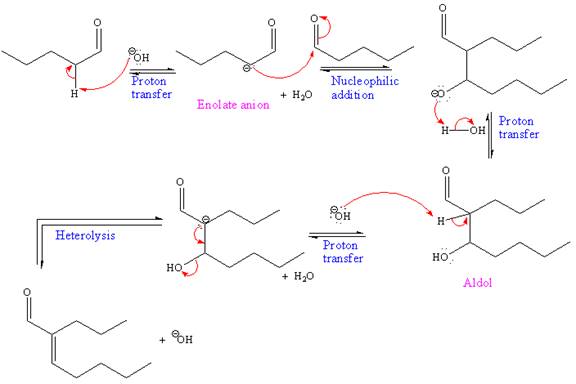
Explanation of Solution
The given reaction is as shown below:

The given reaction is aldol condensation as the sodium hydroxide and heat is given. Firstly, the given aldehyde is treated with sodium hydroxide to produce
The complete, detailed mechanism and the major organic product for the given reaction are shown below:
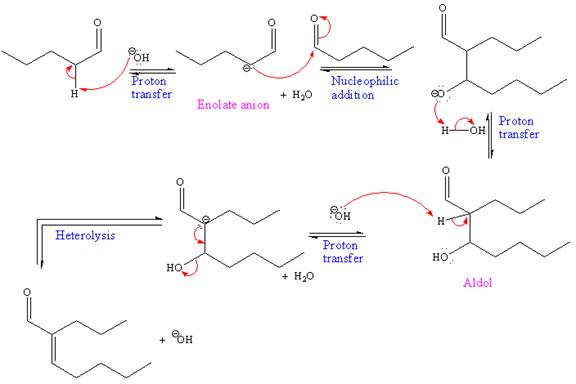
The complete, detailed mechanism and the major organic product for the given reaction are drawn by aldol addition reaction, followed by E1cb mechanism.
(b)
Interpretation:
The complete, detailed mechanism and the major organic product for the given reaction are to be drawn.
Concept introduction:
When an aldehyde is treated with sodium hydroxide, the product
Answer to Problem 18.65P
The complete, detailed mechanism and the major organic product for the given reaction are as shown below:
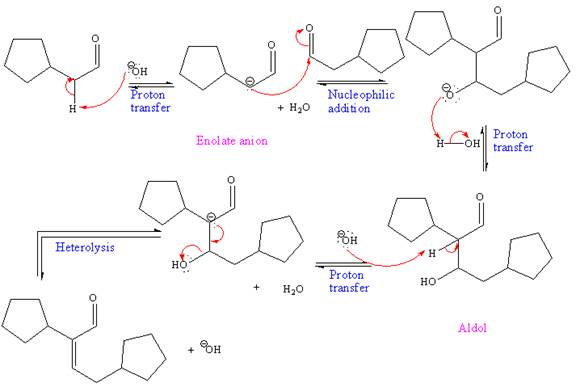
Explanation of Solution
The given reaction is shown below:

The given reaction is aldol condensation as the sodium hydroxide and heat is given. Firstly, the given aldehyde is treated with sodium hydroxide to produce
The complete, detailed mechanism and the major organic product for the given reaction are shown below:
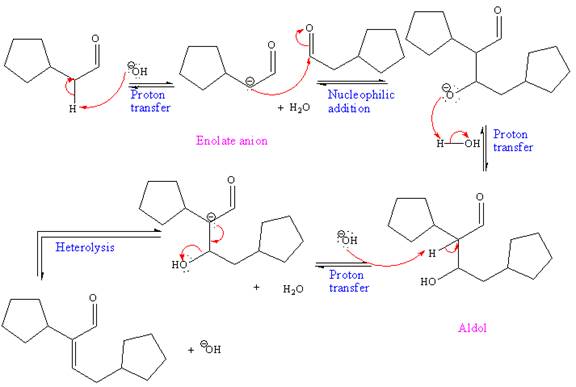
The complete, detailed mechanism and the major organic product for the given reaction are drawn by aldol addition reaction followed by E1cb mechanism.
(c)
Interpretation:
The complete, detailed mechanism and the major organic product for the given reaction is to be drawn.
Concept introduction:
When an aldehyde is treated with sodium hydroxide, the product
Answer to Problem 18.65P
The complete, detailed mechanism and the major organic product for the given reaction are as shown below:
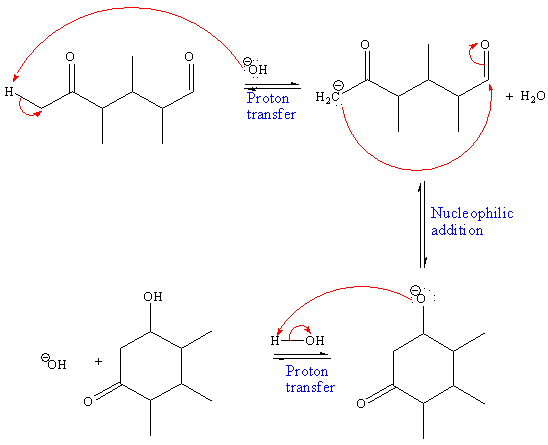
Explanation of Solution
The given reaction is shown below:
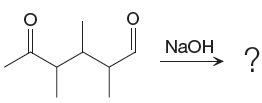
The given reaction is aldol addition as the sodium hydroxide is given. The given aldehyde is treated with sodium hydroxide to produce
The complete, detailed mechanism and the major organic product for the given reaction are shown below:

The complete, detailed mechanism and the major organic product for the given reaction are drawn by intramolecular aldol addition reaction mechanism.
(d)
Interpretation:
The complete, detailed mechanism and the major organic product for the given reaction are to be drawn.
Concept introduction:
When aldehyde is treated with sodium hydroxide, the product
Answer to Problem 18.65P
The complete, detailed mechanism and the major organic product for the given reaction are as shown below:
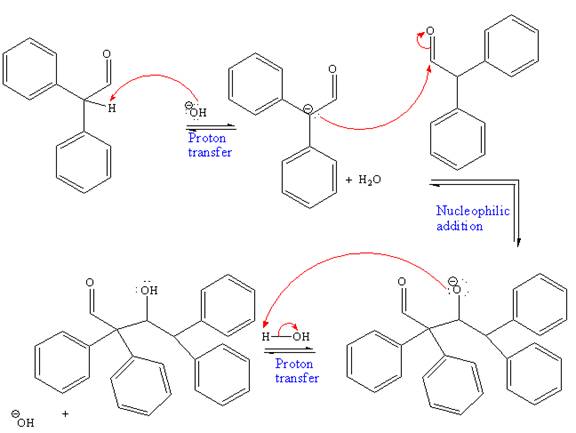
Explanation of Solution
The given reaction is shown below:
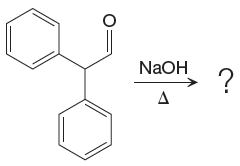
The given reaction is aldol condensation as the sodium hydroxide and heat is given. Firstly, the given aldehyde is treated with sodium hydroxide, to produce
The complete, detailed mechanism and the major organic product for given reaction are shown below:
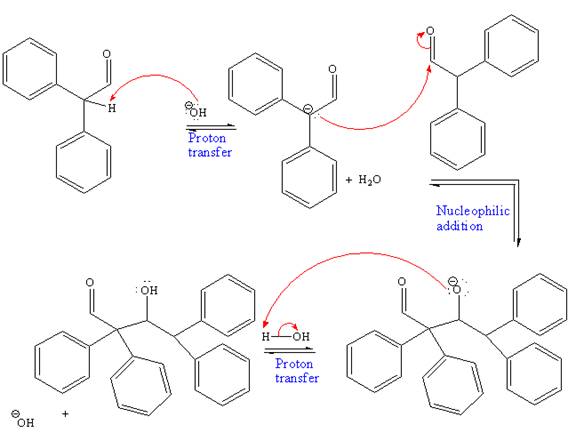
The complete, detailed mechanism and the major organic product for given reaction are drawn on the basis of aldol addition reaction mechanism.
Want to see more full solutions like this?
Chapter 18 Solutions
EBK GET READY FOR ORGANIC CHEMISTRY
- Under aqueous basic conditions, nitriles will react to form a neutral organic intermediate 1 that has an N atom in it first, and then they will continue to react to form the final product 2: NC H₂O он- H₂O 1 2 OH Draw the missing intermediate 1 and the final product 2 in the box below. You can draw the two structures in any arrangement you like. Click and drag to start drawing a structure.arrow_forwardAssign these COSY Spectrumarrow_forwardAssign these C-NMR and H-NMR Spectrumarrow_forward
- Predict the product of this organic reaction: IZ + HO i P+H₂O Specifically, in the drawing area below draw the skeletal ("line") structure of P. If there is no reasonable possibility for P, check the No answer box under the drawing area. No Answer Click and drag to start drawing a structure. ☐ :arrow_forwardPredict the products of this organic reaction: 0 O ----- A + KOH ? CH3-CH2-C-O-CH2-C-CH3 Specifically, in the drawing area below draw the condensed structure of the product, or products, of this reaction. (If there's more than one product, draw them in any arrangement you like, so long as they aren't touching.) If there aren't any products because this reaction won't happen, check the No reaction box under the drawing area. No reaction Click anywhere to draw the first atom of your structure. X ⑤ èarrow_forwardPredict the products of this organic reaction: O CH3 + H2O + HCI A A? CH3-CH2-C-N-CH3 Specifically, in the drawing area below draw the condensed structure of the product, or products, of this reaction. If there's more than one product, draw them in any arrangement you like, so long as they aren't touching. If there aren't any products because this reaction won't happen, check the No reaction box under the drawing area. No Reaction Click anywhere to draw the first atom of your structure.arrow_forward
- What is the missing reactant in this organic reaction? R+ HO-C-CH2-CH3 0= CH3 CH3 —CH, C−NH—CH CH3 + H₂O Specifically, in the drawing area below draw the condensed structure of R. If there is more than one reasonable answer, you can draw any one of them. If there is no reasonable answer, check the No answer box under the drawing area. Note for advanced students: you may assume no products other than those shown above are formed. No Answer Click anywhere to draw the first atom of your structure. €arrow_forward个 CHEM&131 9267 - $25 - Intro to Mail - Hutchison, Allison (Student x Aktiv Learnin https://app.aktiv.com Draw the product of the reaction shown below. Ignore inorganic byproducts. + Na2Cr2O7 Acetone, H2SO4 Type here to search Dryng OH W Prarrow_forwardPredict the products of this organic reaction: OH + NaOH A? Specifically, in the drawing area below draw the skeletal ("line") structure of the product, or products, of this reaction. (If there's more than one product, draw them in any arrangement you like, so long as they aren't touching.) If there aren't any products because this reaction won't happen, check the No reaction box under the drawing area. No reaction Click and drag to start drawing a structure. ✓ Sarrow_forward
- Predict the products of this organic reaction: CH3-C-O-CH2-CH2-C-CH3 + H₂O ? A Specifically, in the drawing area below draw the condensed structure of the product, or products, of this reaction. (If there's more than one product, draw them in any arrangement you like, so long as they aren't touching.) If there aren't any products because this reaction won't happen, check the No reaction box under the drawing area. No reaction Click anywhere to draw the first atom of your structure. :☐ darrow_forwardDE d. Draw an arrow pushing mechanism for the following IN O CI N fo 人 P Polle DELL prt sc home end ins F5 F6 F7 F8 F9 F10 F11 F12arrow_forwardPredict the products of this organic reaction: + H₂O H* ? A Specifically, in the drawing area below draw the skeletal ("line") structure of the product, or products, of this reaction. (If there's more than one product, draw them in any arrangement you like, so long as they aren't touching.) If there aren't any products because this reaction won't happen, check the No reaction box under the drawing area. No Reaction Click and drag to start drawing a structure.arrow_forward
 ChemistryChemistryISBN:9781305957404Author:Steven S. Zumdahl, Susan A. Zumdahl, Donald J. DeCostePublisher:Cengage Learning
ChemistryChemistryISBN:9781305957404Author:Steven S. Zumdahl, Susan A. Zumdahl, Donald J. DeCostePublisher:Cengage Learning ChemistryChemistryISBN:9781259911156Author:Raymond Chang Dr., Jason Overby ProfessorPublisher:McGraw-Hill Education
ChemistryChemistryISBN:9781259911156Author:Raymond Chang Dr., Jason Overby ProfessorPublisher:McGraw-Hill Education Principles of Instrumental AnalysisChemistryISBN:9781305577213Author:Douglas A. Skoog, F. James Holler, Stanley R. CrouchPublisher:Cengage Learning
Principles of Instrumental AnalysisChemistryISBN:9781305577213Author:Douglas A. Skoog, F. James Holler, Stanley R. CrouchPublisher:Cengage Learning Organic ChemistryChemistryISBN:9780078021558Author:Janice Gorzynski Smith Dr.Publisher:McGraw-Hill Education
Organic ChemistryChemistryISBN:9780078021558Author:Janice Gorzynski Smith Dr.Publisher:McGraw-Hill Education Chemistry: Principles and ReactionsChemistryISBN:9781305079373Author:William L. Masterton, Cecile N. HurleyPublisher:Cengage Learning
Chemistry: Principles and ReactionsChemistryISBN:9781305079373Author:William L. Masterton, Cecile N. HurleyPublisher:Cengage Learning Elementary Principles of Chemical Processes, Bind...ChemistryISBN:9781118431221Author:Richard M. Felder, Ronald W. Rousseau, Lisa G. BullardPublisher:WILEY
Elementary Principles of Chemical Processes, Bind...ChemistryISBN:9781118431221Author:Richard M. Felder, Ronald W. Rousseau, Lisa G. BullardPublisher:WILEY





